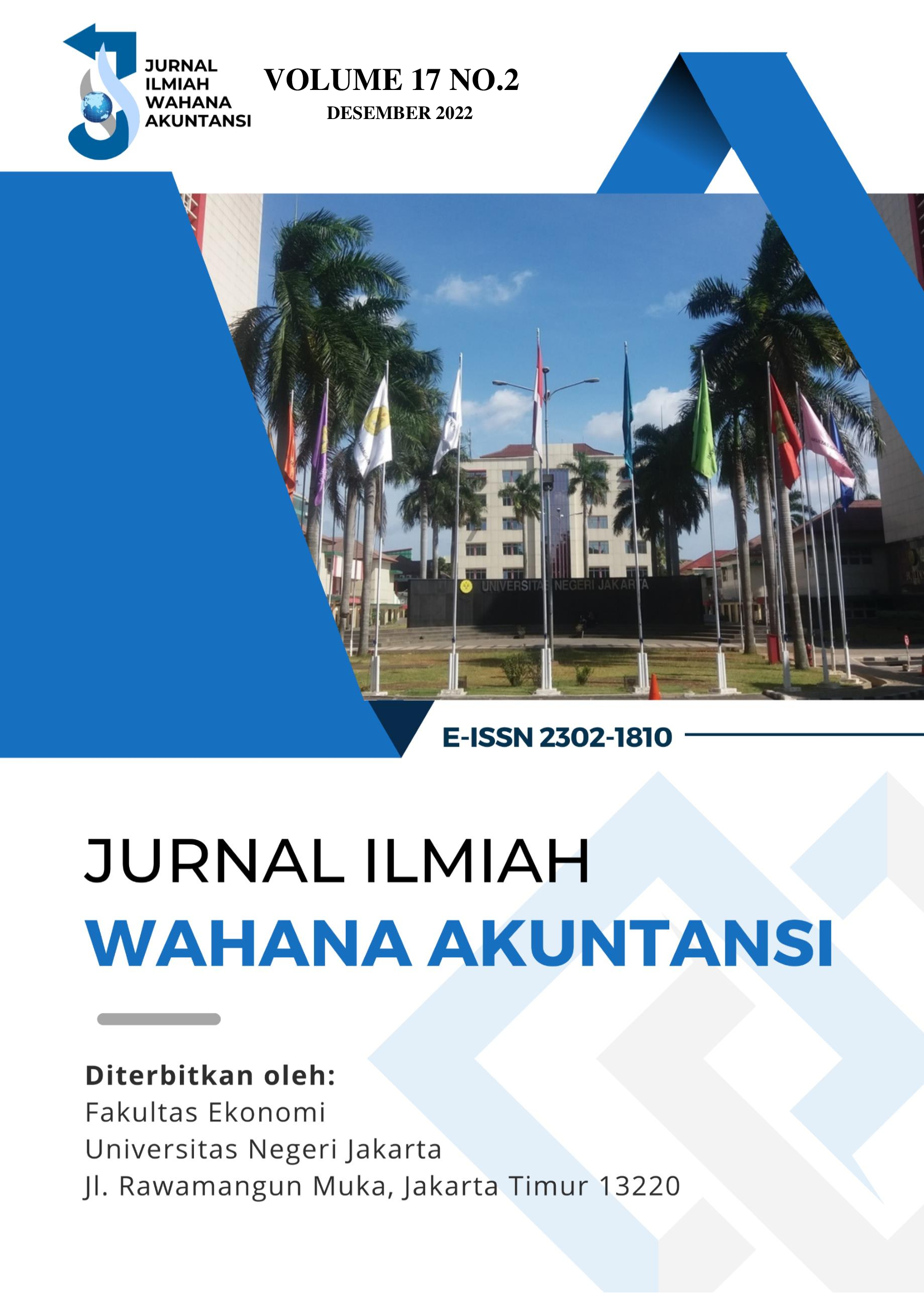Model Teori Fraud Diamond Mempengaruhi Financial Statement Fraud di Moderasi oleh Innovation Strategy
DOI:
https://doi.org/10.21009/Wahana.17.027Keywords:
Financial Statement Fraud, Fraud Diamond, Innovation StrategyAbstract
This study aims to examine the effect of fraud diamond on financial statement fraud and the role of innovation strategy in moderating the effect of fraud diamond on financial statement fraud. The research was conducted on companies listed on the Indonesia Stock Exchange using purposive sampling technique, while the analytical tools used were logistic regression analysis and moderating regression analysis. Samples were obtained from 89 companies registered from 2017-2021. The results showed that the component of the fraud diamond had a significant effect only on the DER variable, while the results of the study proved that the innovation strategy moderated the effect of the fraud diamond on the financial statement fraud.
References
Andoh, C., Quaye, D., & Akomea-Frimpong, I. (2018). Impact of Fraud on Ghanaian SMEs and Coping mechanisms. Journal of Financial Crime, 25(2), 400–418. https://doi.org/10.1108/JFC-05-2017-0050
Angelina, C., & Christian, N. (2022). Analisis Teori Fraud Pentagon S.C.O.R.E Method dalam Mendeteksi Fraud pada Laporan Keuangan Perusahaan. Jurnal Ilmiah Akuntansi dan Keuangan, 5(1), 485–497.
Anindya, J. R., & Adhariani, D. (2019). Fraud Risk Factors and Tendency to Commit Fraud: Analysis of Employees’ Perceptions. International Journal of Ethics and Systems, 35(4), 545–557. https://doi.org/10.1108/IJOES-03-2019-0057
Ashfaq, K., & Rui, Z. (2019). The Effect of Board and Audit Committee Effectiveness on Internal Control Disclosure under Different Regulatory Environments in South Asia. Journal of Financial Reporting and Accounting, 17(2), 170–200. https://doi.org/10.1108/JFRA-09-2017-0086
Association of Certified Fraud Examiners (ACFE). (2020). Report to the Nations 2020 Global Study on Occupational Fraud and Abuse. Association of Certified Fraud Examiners, Inc.
Avortri, C., & Agbanyo, R. (2020). Determinants of Management Fraud in the Banking Sector of Ghana: The Perspective of the Diamond Fraud Theory. Journal of Financial Crime, 28(1), 142–155. https://doi.org/10.1108/JFC-06-2020-0102
Bakri, H. H. M., Mohamed, N., & Said, J. (2017). Mitigating Asset Misappropriation through Integrity and Fraud Risk Elements: Evidence Emerging Economies. Journal of Financial Crime, 24(2), 242–255. https://doi.org/10.1108/JFC-04-2016-0024
Baskaran, S., Nedunselian, N., Ng, C. H., Mahadi, N., & Abdul Rasid, S. Z. (2020). Earnings management: A Strategic Adaptation or Deliberate Manipulation? Journal of Financial Crime, 27(2), 369–386. https://doi.org/10.1108/JFC-07-2019-0098
Chang, J.-C., & Sun, H.-L. (2016). Reputation and Regulation Effects on Director Turnover and Change of Directorships. Review of Accounting and Finance, 15(3), 274–293. https://doi.org/10.1108/RAF-12-2014-0138
Chatterjee, M., & Bhattacharjee, T. (2021). Ownership Concentration, Innovation and Firm Performance: Empirical Study in Indian Technology SME Context. South Asian Journal of Business Studies, 10(2), 149–170. https://doi.org/10.1108/SAJBS-10-2019-0185
Chouaibi, J., Zouari, G., & Khlifi, S. (2019). How Does the Real Earnings Management Affect Firms Innovative? Evidence from US Firms. International Journal of Law and Management, 61(1), 151–169. https://doi.org/10.1108/IJLMA-10-2017-0240
Erdoğan, M., & Erdoğan, E. O. (2020). Financial Statement Manipulation: A Beneish Model Application. In Contemporary Issues in Audit Management and Forensic Accounting(Vol. 102, pp. 173–188). https://doi.org/10.1108/s1569-375920200000102014
Gbegi, D. ., & Adebisi, J. F. P. . (2013). The New Fraud Diamond Model - How Can It Help Forensic Accountants in Fraud Investigation in Nigeria? European Journal of Accounting Auditing and Fiancé Research, 1(4), 129–138.
Gunasegaran, M., Basiruddin, R., Abdul Rasid, S. Z., & Mohd Rizal, A. (2018). The Case Studies of Fraud Prevention Mechanisms in the Malaysian Medium Enterprises. Journal of Financial Crime, 25(4), 1024–1038. https://doi.org/10.1108/JFC-05-2017-0034
Hashim, H. A., Salleh, Z., Shuhaimi, I., & Ismail, N. A. N. (2020). The risk of Financial Fraud: A Management Perspective. Journal of Financial Crime, 27(4), 1143–1159. https://doi.org/10.1108/JFC-04-2020-0062
Hidajat, T. (2020). Rural Banks Fraud: A Story from Indonesia. Journal of Financial Crime, 27(3), 933–943. https://doi.org/10.1108/JFC-01-2020-0010
Homer, E. M. (2020). Testing the Fraud Triangle: A Systematic Review. Journal of Financial Crime, 27(1), 172–187. https://doi.org/10.1108/JFC-12-2018-0136
Kalovya, O. Z. (2020). Determinants of Occupational Fraud Losses: Offenders, Victims and Insights from Fraud Theory. Journal of Financial Crime. https://doi.org/10.1108/JFC-10-2019-0136
Kanapickienė, R., & Grundienė, Ž. (2015). The Model of Fraud Detection in Financial Statements by Means of Financial Ratios. Procedia -Social and Behavioral Sciences, 213, 321–327. https://doi.org/10.1016/j.sbspro.2015.11.545
Khamainy, A. H., Ali, M., & Setiawan, M. A. (2021). Detecting Financial Statement Fraud through New Fraud Diamond Model: The Case of Indonesia. Journal of Financial Crime. https://doi.org/10.1108/JFC-06-2021-0118
Lau, C. K., & Ooi, K. W. (2016). A Case Study on Fraudulent Financial Reporting: Evidence from Malaysia. Accounting Research Journal, 29(1), 4–19. https://doi.org/10.1108/ARJ-
11-2013-0084Maulidi, A. (2020). When and Why (Honest) People Commit Fraudulent Behaviours?: Extending the Fraud Triangle as a Predictor of Fraudulent Behaviours. Journal of Financial Crime, 27(2), 541–559. https://doi.org/10.1108/JFC-05-2019-0058
Monteverde, V. H. (2020). Microeconomics of Corruption Based on Behavioural Economics. Journal of Financial Crime. https://doi.org/10.1108/JFC-03-2020-0043
Nasir, N. A. B. M., Ali, M. J., & Ahmed, K. (2019). Corporate Governance, Board Ethnicity and Financial Statement Fraud: Evidence from Malaysia. Accounting Research Journal, 32(3), 514–531. https://doi.org/10.1108/ARJ-02-2018-0024
Nasir, N. A. B. M., Ali, M. J., Razzaque, R. M. R., & Ahmed, K. (2018). Real Earnings Management and Financial Statement Fraud: Evidence from Malaysia. International Journal of Accounting & Information Management, 26(4), 508–526. https://doi.org/10.1108/IJAIM-03-2017-0039
Nawawi, A., & Salin, A. S. A. P. (2018). Internal Control and Employees’ Occupational Fraud on Expenditure Claims. Journal of Financial Crime, 25(3), 891–906. https://doi.org/10.1108/JFC-07-2017-0067
Omar, M., Nawawi, A., & Salin, A. S. A. P. (2016). The Causes, Impact and Prevention of Employee Fraud: A Case Study of an Automotive Company. Journal of Financial Crime, 23(4), 1012–1027. https://doi.org/10.1108/JFC-04-2015-0020
Omukaga, K. O. (2020). Is the Fraud Diamond Perspective Valid in Kenya? Journal of Financial Crime, 28(3), 810–840. https://doi.org/10.1108/JFC-11-2019-0141
Ozcelik, H. (2020). An Analysis of Fraudulent Financial Reporting Using the Fraud Diamond Theory Perspective: An Empirical Study on the Manufacturing Sector Companies Listed on the Borsa Istanbul. In Contemporary Issues in Audit Management and Forensic Accounting(Vol. 102, pp. 131–153). https://doi.org/10.1108/s1569-375920200000102012
Qiu, Q., & Yu, D. (2020). The Impacts of CEO’s Knowledge Structure on Corporate Innovation Strategy.
Kybernetes, 50(9), 2597–2618. https://doi.org/10.1108/K-03-2020-0131Repousis, S. (2016). Using Beneish Model to Detect Corporate Financial Statement Fraud in Greece. Journal of Financial Crime, 23(4), 1063–1073. https://doi.org/10.1108/JFC-11-2014-0055
Rustiarini, N. W., T, S., Nurkholis, N., & Andayani, W. (2019). Why People Commit Public Procurement Fraud? The Draud Diamond View. Journal of Public Procurement, 19(4), 345–362. https://doi.org/10.1108/JOPP-02-2019-0012
Salehi, M., Mahmoudabadi, M., & Adibian, M. S. (2018). The Relationship between Managerial Entrenchment, Earnings Management and Firm Innovation. International Journal of Productivity and Performance Management, 67(9), 2089–2107. https://doi.org/10.1108/IJPPM-03-2018-0097
Septriyani, Y., & Handayani, D. (2018). Mendeteksi Kecurangan Laporan Keuangan dengan Analisis Fraud Pentagon. Jurnal Akuntansi, Keuangan Dan Bisnis, 11(1), 11–23.Umar, H., Partahi, D., & Purba, R. B. (2020). Fraud Diamond Analysis in Detecting Fraudulent Financial Report.International Journal of Scientific and Technology Research, 9(3), 6638–6646.Utami, I., Wijono, S., Noviyanti, S., & Mohamed, N. (2019). Fraud Diamond, Machiavellianism and Fraud intention. International Journal of Ethics and Systems, 35(4), 531–544. https://doi.org/10.1108/IJOES-02-2019-0042
Varadarajan, R. (2018). Innovation, Innovation Strategy, and Strategic Innovation. Review of Marketing Research, 15, 143–166. https://doi.org/10.1108/S1548-643520180000015007
Vousinas, G. L. (2019). Advancing Theory of Fraud: The S.C.O.R.E Model. Journal of Financial Crime, 26(1), 372–381. https://doi.org/10.1108/JFC-12-2017-0128
Zakaria, K. M., Nawawi, A., & Salin, A. S. A. P. (2016). Internal Controls and Fraud –Empirical Evidence from Oil and Gas Company. Journal of Financial Crime, 23(4), 1154–1168. https://doi.org/10.1108/JFC-04-2016-0021
Downloads
Published
How to Cite
Issue
Section
License

Jurnal Ilmiah Wahana Akuntansi is licensed under a Creative Commons Attribution-NonCommercial-ShareAlike 4.0 International License.
Articles in Jurnal Ilmiah Wahana Akuntansi are Open Access articles published under the Creative Commons CC BY-NC-SA License. This license permits use, distribution and reproduction in any medium for non-commercial purposes only, provided the original work and source is properly cited. Any derivative of the original must be distributed under the same license as the original.











